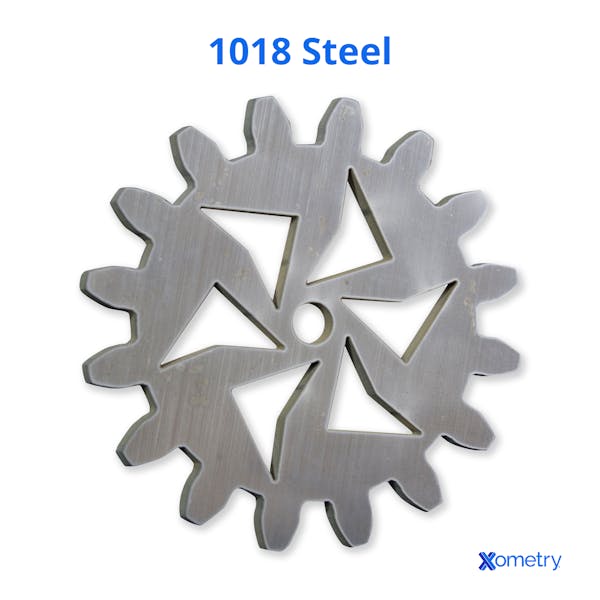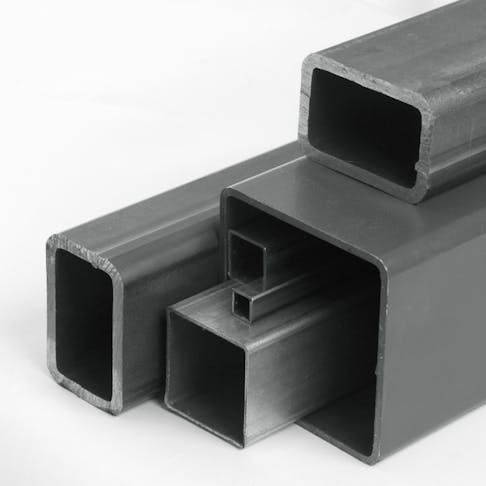Known in industry for its adaptability and machinability, 1018 is a low-carbon, mild steel used to make many different parts with clean cuts and smooth surfaces. These include structural and precision parts, fasteners, pistons, sprockets, gears, shafts, pins, hinges, bolts, studs, axles, and vehicle panels, among many others. In this guide, we’ll detail all the important need-to-know details about this useful steel, including its composition, properties, and forms.
What is 1018 Steel?
As the most common (or at least one of them) cold-rolled steels in the world, 1018 is classed as a free-machining steel grade, meaning that small chips form when it’s machined. This is a good thing as it makes it easier to work with and manipulate into whatever shape you need. That, and its great tool life, is why it’s so often chosen by those in machining. Like all the other steels in its category, 1018 is mostly made up of iron, with manganese as its main alloying element, followed by carbon and trace amounts of sulfur and phosphorus. It’s the carbon in its makeup that makes 1018 so easy to form with cold forming, bending, and crimping.
It can be welded with the MIG (metal inert gas) and TIG (tungsten inert gas) processes, but will need preheating and heat treatment after welding to reduce the likelihood of cracks or distortion. In machining, 1018 is chosen for its good chip formation and tool life. It’s a staple for engineering and structural uses due to how easy it is to fabricate with a bunch of methods and finishing work, and its simple composition, which keeps its cost on the low side. It’s also easy to get—it’s widely available and you’re not likely to be put on a waiting list for it.
To make 1018, there are typically two steelmaking steps, as follows:
Primary: The first step is removing the excess carbon and any impurities from pig iron by blowing air through the melt so that it oxidizes.
Secondary: The molten metal is then transferred to a large container called a ladle (no, not the soup kind—this one is shaped like a bucket and has a 44-pound weight capacity—but it does have a handy spout), and the alloy metals are added to it. All this happens at highly controlled temperatures to make sure all the right chemical reactions are obtained for the final metal to have the necessary properties.
This steel comes in many forms, and you’ll choose the best one for the job, according to what you need to make. In addition to cold-rolled, it comes in round, square, or hexagon-shaped bars, sheets, and plates, and wire.

| Chemical | Percentage |
|---|---|
Chemical Carbon (C) | Percentage 0.18 % |
Chemical Iron (Fe) | Percentage 98.81 – 99.26 % |
Chemical Sulfur (S) | Percentage ≤ 0.050 % |
Chemical Phosphorous (P) | Percentage ≤ 0.040 % |
Chemical Manganese (Mn) | Percentage 0.60 – 0.90 % |
Chemical Composition of 1018 Steel
Let’s break down what qualities these elements give to 1018. At a microscopic level, 1018’s internal structure is a mix of pearlite (the hard and strong part) and ferrite (the softer, more bendable part). As with most other carbon steels, the iron makes this metal magnetic. The low amount of carbon makes it ductile, easy to forge with a variety of methods (i.e., blacksmithing), and less prone to cracking during welding (but as mentioned earlier, you’ll have to do some post-welding work).
In general, it won’t be the best option for super strong, very hard, or wear-resistant parts, but you could treat it to make it more appropriate for high-wear applications. While this is the steel to choose for making carburized parts (it responds impeccably to case hardening and forms a harder surface layer), you wouldn’t want to make knives from it.
Properties
The below table lists 1018’s physical properties.
| Property | Value |
|---|---|
Property Density | Value 7.87 g/cm^3 |
Property Yield Strength | Value 370 MPa |
Property Hardness | Value Brinell - 126 |
Property Magnetism | Value Generally magnetic |
Properties of 1018 Steel
As you can see, it’s not the strongest or hardest in its category, but it’s as tough as it can be in order to remain malleable for fabrication. When hot-rolled, its machinability and hardness levels are increased. It could also be susceptible to wear (without treatment) and corrosion, as it has a lower alloy content than some of its counterparts.
Temperature Guide
We’ve listed out the different temperatures that 1018 steel needs to reach for certain processes in the table below.
| Process | Temperature |
|---|---|
Process Annealing | Temperature 1,550–1,620°F |
Process Carburizing | Temperature 1,650–1,700°F |
Process Case hardening | Temperature 1,500–1,600°F |
Process Core refinement | Temperature 1,450–1,500°F |
Process Forging | Temperature 2,100–2,250°F |
Process Normalizing | Temperature 1,650–1,700°F |
Process Stress relief | Temperature 1,000–1,200°F |
1018 Steel Temperature Guide
| Country | Equivalent Steel Name |
|---|---|
Country China | Equivalent Steel Name 15 # |
Country European Union | Equivalent Steel Name C15E (1.1141) |
Country Germany | Equivalent Steel Name 1.0401, C15, CK15 |
Country France | Equivalent Steel Name XC15 |
Country United Kingdom | Equivalent Steel Name 080M15 |
Country Japan | Equivalent Steel Name S15C |
Equivalents of 1018 Steel
1018 Steel vs. Other Steel Types
1112 steel has 100% machinability to 1018’s 70–78% (which is obviously still impressive), while the higher carbon content in 4140, 1045, and A36 steels give them more corrosion and wear resistance, and tensile and yield strength than 1018. A36 also has a different production process—it’s hot-rolled, whereas 1018 is cold-rolled. It’s not a stainless steel, either, because it doesn’t have chromium in it (otherwise it would be rust-resistant).
How Xometry Can Help
If you’re after a highly formable carbon steel, 1018 might be just what you need. If strength or hardness are at the top of your priority list (perhaps you need to make parts that are more resistant to wear and the elements), you might want to look into a medium-carbon steel instead. Reach out to one of our reps for more information and/or guidance in the right direction, or upload your designs to our Instant Quoting Engine for a free quote and no-obligation quote.
Disclaimer
The content appearing on this webpage is for informational purposes only. Xometry makes no representation or warranty of any kind, be it expressed or implied, as to the accuracy, completeness, or validity of the information. Any performance parameters, geometric tolerances, specific design features, quality and types of materials, or processes should not be inferred to represent what will be delivered by third-party suppliers or manufacturers through Xometry’s network. Buyers seeking quotes for parts are responsible for defining the specific requirements for those parts. Please refer to our terms and conditions for more information.


